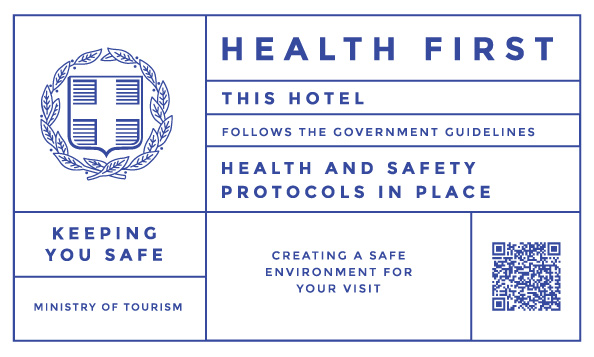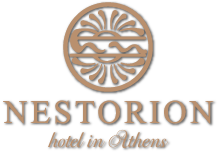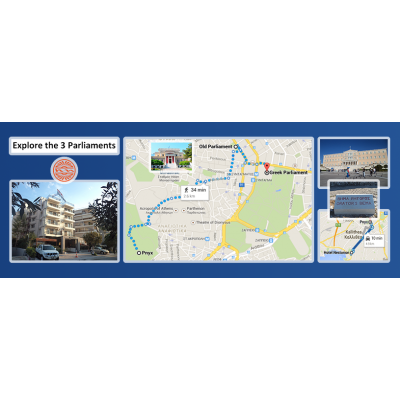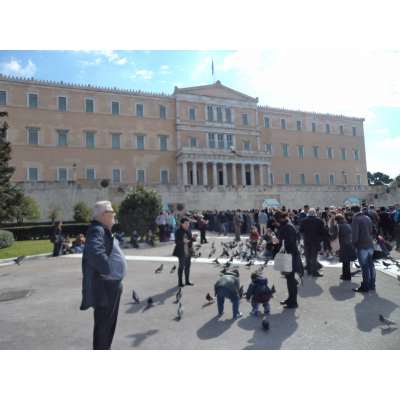3 Κοινοβούλια
the budget hotel in athens
Τα 3 Κοινοβούλια
https://goo.gl/maps/KDSVo
Είναι φανερό πως η Αθήνα είναι μία πόλις ιδανική για city break. Ο μέσος όρος παραμονής του διαδικτυακού τουρίστα είναι περίπου 3 διανυκτερεύσεις. Κάπου στο μυαλό χιλιάδων τουριστών προσλαμβάνεται ως μια ιερή ή ιστορική, αν θέλετε, υποχρέωση το πέρασμα από την Αθήνα στο πρόγραμμα των διακοπών τους.
Ερχόμενοι οι τουρίστες στην Αθήνα είτε προγραμματισμένα είτε όχι θέλουν να απολαύσουν λίγα απ' όλα. Μουσεία, φαγητά, διασκέδαση, εκδηλώσεις, αποδράσεις, ήλιο και θάλασσα. Το διαδίκτυο είναι πολύ πλούσιο από προτάσεις. To Nestorion με τη βοήθεια του διαδικτύου και των πλούσιων εντύπων φορέων της πολιτείας συνθέτει ιδέες και προτάσεις τις οποίες θέλει να μοιράζεται με τους πελάτες του.
Αυτή τη φορά η πρόταση μας είναι η επίσκεψη των τριών ιστορικών Κοινοβουλίων με έναρξη από την Πνύκα. Η πρότασή μας έχει θεωρητική αλλά και πρακτική αξία και φυσικά μπορεί να εμπλουτιστεί με επίσκεψη στη Πλάκα (Παλιά πόλη) και το Κέντρο της Πόλης (shopping area)
Θα μοιραστούμε:
1. Κατάλυμα διαμονής : http://www.nestoriohotel.gr
2. Διαδρομή πρόσβασης : Π.Φάληρο - Πνυξ : https://goo.gl/maps/OzeZu
3. Περίπατος επίσκεψης : 3 Βουλές : https://goo.gl/maps/KDSVo
4. Ελεύθερος Χρόνος : 2-3 ώρες
5. Διαδρομή επιστροφής στο ξενοδοχείο διαμονής : https://goo.gl/maps/RyJ8c
Best to visit: The 3 Parliaments
https://goo.gl/maps/KDSVo
1. PNYX
http://www.stoa.org/athens/sites/pnyx.html
1. Property to stay: http://www.nestoriohotel.gr
2. Access Route: P.Faliro - Pnyx: https://goo.gl/maps/OzeZu
Visit Walking: 3 Houses: https://goo.gl/maps/KDSVo
3. Leisure time: 2-3 hours
4. Return Path in hotel: https://goo.gl/maps/RyJ8c
Pnyx is situated between the hill of the Muses (the location Philoppappus Monument) and the Hill of the Nymphs, (the location of the sanctuary of the Nymphs and the national Observatory). The semicircular square was after 6th century BC the location of the assembly of the people of Athens. They gathered here to hear orators to speak from a rock platform (bema) in the center of the Pnyx, and participate in the democratic assembly. The assembly is thought to have had a capacity of 10.000
2. OLD PARLIAMENT
http://www.athens24.com/the-old-parliament-house.html
http://www.nhmuseum.gr/facilities2.php?lang=1
Mansion of Old Parliament was founded in 1858 by Queen Amalia and built to plans by Francois Boulanger.
The Palace is directly connected with Greek history: it is the first permanent home of the Greek Parliament. With the expulsion of King Otto and the restoration of 1862 repealed the body of the Senate. The building plans are modified by Greek architect Panagiotis Kalkos main change with the abolition of the amphitheater of the Senate. The Parliament building is completed in 1875.
On August 11 performed the official opening of the sittings of the Parliament by Prime Minister Charilaos Trikoupis. For 60 years the building on Stadiou Street houses the turbulent political life of the country. In 1935 the Greek Parliament relocates the Old Palace in Syntagma Square. The building of the Old House now granted by decision of the Prime Minister Eleftherios Venizelos in the Historical and Ethnological Society of Greece in order to house the National History Museum. The fact later confirmed by decree but delayed to implement because of the war and the events that followed.
Today, the Old Parlament is an architectural jewel in the center of Athens. The grand hall of the Conference is historical memory and adequate housing for important historical and cultural events. The halls that surround it house the permanent exhibition of the National Historical Museum and the gallery is the temporary exhibitions space.
3. THE GREEK PARLIAMENT
http://foundation.parliament.gr/central.aspx?sId=106I344I938I323I434741
Dominating Syntagma Square, the building was the residence of the first king of Greece Otto. The building was constructed from 1836 to 1842, George A’, who succeeded Otto on the throne, also resided in the palace. During his reign, two successive fires destroyed the building, making it unsuitable for use as a royal residence. In 1924 the government decided to situate Parliament in the building. Reconstruction work was completed in 1934. The interior was redesigned by architect A.Kriezis. In Parliament you will find national treasures, such as the first Greek Constitution, a collection of valuable paintings and a large library.
https://goo.gl/maps/KDSVo
Είναι φανερό πως η Αθήνα είναι μία πόλις ιδανική για city break. Ο μέσος όρος παραμονής του διαδικτυακού τουρίστα είναι περίπου 3 διανυκτερεύσεις. Κάπου στο μυαλό χιλιάδων τουριστών προσλαμβάνεται ως μια ιερή ή ιστορική, αν θέλετε, υποχρέωση το πέρασμα από την Αθήνα στο πρόγραμμα των διακοπών τους.
Ερχόμενοι οι τουρίστες στην Αθήνα είτε προγραμματισμένα είτε όχι θέλουν να απολαύσουν λίγα απ' όλα. Μουσεία, φαγητά, διασκέδαση, εκδηλώσεις, αποδράσεις, ήλιο και θάλασσα. Το διαδίκτυο είναι πολύ πλούσιο από προτάσεις. To Nestorion με τη βοήθεια του διαδικτύου και των πλούσιων εντύπων φορέων της πολιτείας συνθέτει ιδέες και προτάσεις τις οποίες θέλει να μοιράζεται με τους πελάτες του.
Αυτή τη φορά η πρόταση μας είναι η επίσκεψη των τριών ιστορικών Κοινοβουλίων με έναρξη από την Πνύκα. Η πρότασή μας έχει θεωρητική αλλά και πρακτική αξία και φυσικά μπορεί να εμπλουτιστεί με επίσκεψη στη Πλάκα (Παλιά πόλη) και το Κέντρο της Πόλης (shopping area)
Θα μοιραστούμε:
1. Κατάλυμα διαμονής : http://www.nestoriohotel.gr
2. Διαδρομή πρόσβασης : Π.Φάληρο - Πνυξ : https://goo.gl/maps/OzeZu
3. Περίπατος επίσκεψης : 3 Βουλές : https://goo.gl/maps/KDSVo
4. Ελεύθερος Χρόνος : 2-3 ώρες
5. Διαδρομή επιστροφής στο ξενοδοχείο διαμονής : https://goo.gl/maps/RyJ8c
Best to visit: The 3 Parliaments
https://goo.gl/maps/KDSVo
1. PNYX
http://www.stoa.org/athens/sites/pnyx.html
1. Property to stay: http://www.nestoriohotel.gr
2. Access Route: P.Faliro - Pnyx: https://goo.gl/maps/OzeZu
Visit Walking: 3 Houses: https://goo.gl/maps/KDSVo
3. Leisure time: 2-3 hours
4. Return Path in hotel: https://goo.gl/maps/RyJ8c
Pnyx is situated between the hill of the Muses (the location Philoppappus Monument) and the Hill of the Nymphs, (the location of the sanctuary of the Nymphs and the national Observatory). The semicircular square was after 6th century BC the location of the assembly of the people of Athens. They gathered here to hear orators to speak from a rock platform (bema) in the center of the Pnyx, and participate in the democratic assembly. The assembly is thought to have had a capacity of 10.000
2. OLD PARLIAMENT
http://www.athens24.com/the-old-parliament-house.html
http://www.nhmuseum.gr/facilities2.php?lang=1
Mansion of Old Parliament was founded in 1858 by Queen Amalia and built to plans by Francois Boulanger.
The Palace is directly connected with Greek history: it is the first permanent home of the Greek Parliament. With the expulsion of King Otto and the restoration of 1862 repealed the body of the Senate. The building plans are modified by Greek architect Panagiotis Kalkos main change with the abolition of the amphitheater of the Senate. The Parliament building is completed in 1875.
On August 11 performed the official opening of the sittings of the Parliament by Prime Minister Charilaos Trikoupis. For 60 years the building on Stadiou Street houses the turbulent political life of the country. In 1935 the Greek Parliament relocates the Old Palace in Syntagma Square. The building of the Old House now granted by decision of the Prime Minister Eleftherios Venizelos in the Historical and Ethnological Society of Greece in order to house the National History Museum. The fact later confirmed by decree but delayed to implement because of the war and the events that followed.
Today, the Old Parlament is an architectural jewel in the center of Athens. The grand hall of the Conference is historical memory and adequate housing for important historical and cultural events. The halls that surround it house the permanent exhibition of the National Historical Museum and the gallery is the temporary exhibitions space.
3. THE GREEK PARLIAMENT
http://foundation.parliament.gr/central.aspx?sId=106I344I938I323I434741
Dominating Syntagma Square, the building was the residence of the first king of Greece Otto. The building was constructed from 1836 to 1842, George A’, who succeeded Otto on the throne, also resided in the palace. During his reign, two successive fires destroyed the building, making it unsuitable for use as a royal residence. In 1924 the government decided to situate Parliament in the building. Reconstruction work was completed in 1934. The interior was redesigned by architect A.Kriezis. In Parliament you will find national treasures, such as the first Greek Constitution, a collection of valuable paintings and a large library.




